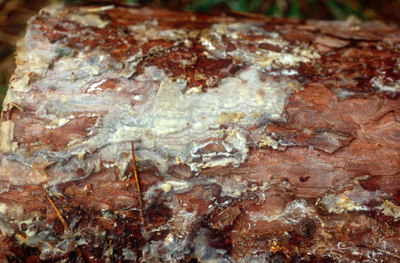Cone-bearing trees such as spruces, pines and firs are softwoods that can survive in cold temperatures and acidic soil. Primarily found in the Northern hemisphere, coniferous forests thrive in regions with long, harsh winters and have adapted to reduce water loss in freezing conditions. These forests are marked by thick canopies that reduce the amount of sunlight filtering through to the forest floor.
Phlebiopsis gigantea is a common fungus that is considered the most damaging root pathogen of coniferous trees in the Northern hemisphere. It spreads by contact of infected roots with healthy ones, and can break down conifer logs and stumps. The fungus was used as a biological control of annosum root rot for several decades in the United States and is still being used as such in western Europe. Freshly cut pine stumps treated with the fungus resist infection by the white-rot fungus Heterobasidion annosum without the need for phytotoxic chemicals. Additionally P. gigantea is being used as a biocontrol for blue-stain fungi such as Ophiostoma. Currently, the U.S. Environmental Protection Agency is reviewing the status of P. gigantea as a pesticide.
By sequencing the genome of the fungus, researchers hope to identify genes that are key for lignin degradation, and use them toward commercializing biofuel production.
Principal Investigators: Daniel Cullen, US Forest Service, Forest Products Laboratory
Program: CSP 2010
